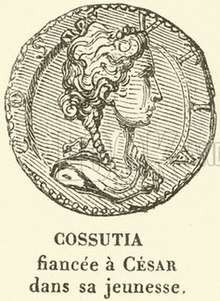Cossutia
Cossutia was a woman from a modest Roman family who became engaged to Julius Caesar prior to his reaching adulthood. There has been debate among historians on if the marriage actually occurred.
Cossutia | |
|---|---|
 Cossutia, fiancée of Julius Caesar | |
| Born | |
| Died | |
| Known for | Possibly being the first wife of Julius Caesar |
| Spouse(s) | Julius Caesar (disputed) |
Biography
Caesar
Cossutia appealed to Caesar,[2] although the Cossuti were not even novi homines.[3] She was recommended to Caesar by his father and it is believed that the future dictator of Rome married Cossutia after he began wearing the toga virilis.[4] Both families issued coins with her image stating Uxor Caesaris.[5] No children sprang from this relation. In 84 B.C., after his father's death, Caesar left Cossutia and married to Cornelia, as that was more pragmatic than the earlier relation to Cossutia.[2] It is also possible that Caesar choose to leave her to marry Cornelia because he had been nominated as Flamen Dialis, a priesthood position which demanded one to be married to a Patrician via confarreatio.[6]
Later years
Cossutia perhaps died in Pisa, Italy in 84 B.C.[7]
Scholarly disagreement
In the past it was commonly accepted that Caesar and Cossutia were married but modern opinions differ. Among those who believe Caesar was never married to this woman include Ludwig Friedrich Otto Baumgarten-Crusius, Napoleon III, Merrivale, James Anthony Froude, Dodge, Warde Fowler, Ernest Gottlieb Sihler, Adolf von Mess, and John Carew Rolfe.[4] The French author Marie-Nicolas Bouillet lists Cossutia first, then Cornelia, Pompeia, and Calpurnia, as wives of Caesar. Ancient historian Plutarch largely ignores Cossutia,[7] but names her as one of Caesar's wives.[8] Suetonius also used the word for an official divorce when describing the break off.[9] [10]
Cultural depictions
Cossutia appears as a major character in the opera Young Caesar, and as a minor character in several novels.[11]
See also
References
- Gaius Suetonius Tranquillus, De Vita Caesarum, Caesar, 1.
- Women of Caesar's Family, The Classical Journal, Volume 13, 1918, pp. 502-506.
- Betrothed Whom Caesar Rejected, Frederick Stanley Dunn, University of Oregon extension monitor, Volume 1, Issue 2, 1913, pp. 1-4.
- Notes and Discussions — "Caesar's First Wife", Classical Philology, Volume 12, 1917, pg. 93.
- Jonathan Sawday, Neil Rhodes; The Renaissance Computer: Knowledge Technology in the First Age of Print - page: 62
- Tom Stevenson; Julius Caesar and the Transformation of the Roman Republic - page: 42
- American Notes and Queries, Volume 1, 1888, pg. 20.
- Plutarchus; Plutarch Caesar: Translated with an Introduction and Commentary - page: 152
- Caesar: Life of a Colossus, Adrian Goldsworthy, Yale University Press, 2008, pg. 49.
- https://books.google.se/books?id=XGf7JBvkPU0C&pg=PA130&dq=%22Suetonius%22+%22cossutia%22&hl=sv&sa=X&ved=0ahUKEwj-rr7u2uXlAhXxmIsKHQC0CncQ6AEIaDAH#v=onepage&q=%22Suetonius%22%20%22cossutia%22&f=false
- https://books.google.se/books?id=FmTpeYiHMOYC&pg=PA567&dq=%22sulla%22+julia+second+child+-pompey&hl=sv&sa=X&ved=0ahUKEwjsrdf2zPjoAhVh1qYKHQxzBYsQ6AEIKjAA#v=onepage&q=%22sulla%22%20julia%20second%20child%20-pompey&f=false
External links
| Wikimedia Commons has media related to Cossutia (fiancée of Caesar). |